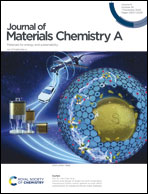Understanding the role of acid–base interactions using architecturally-controlled, pyridyl-bearing sulfonated phenylated polyphenylenes†
Abstract
Acid–base interactions between N-heterocycles and sulfonic acid groups are known to mitigate the excessive swelling of hydrocarbon-based proton exchange polymers, but concurrently reduce the concentration of hydrated protons therein, which lowers proton conductivity. We report sulfonated phenylated poly(phenylene) homopolymers designed with similar architecture but with an increasing number of strategically-placed N-atoms in the form of pyridyl units. It is discovered that polymers with 2 or more pyridines per repeat unit do not stoichiometrically neutralize pendent sulfonic acids. For example, four pyridines per repeat unit neutralize the equivalent of ∼2 sulfonic acids, resulting in a reduced number of pyridinium (H+)–sulfonate cross links than anticipated. DFT calculations reveal that externally-exposed pyridine groups form a stronger interaction with protons than a sterically-hindered pyridine that affects mechanical properties and water sorption. Nonetheless, as the number of N-atoms is increased, the fraction of neutralized –SO3H protons is increased, and the material's ion exchange capacity, proton conductivity, liquid and vaporous water sorption, dimensional swelling, steady-state water permeability, and transient diffusivity all decrease. With four pyridyl groups per repeating unit, dimensional swelling of the fully hydrated polymer, steady-state water permeability are similar to the Nafion N211 reference material. However, proton conductivities under reduced RH are substantially reduced due to their low water sorption. This work provides insight into tailoring proton exchange membranes via acid–base, self-neutralization for the purpose of controlling their transport properties.


 Please wait while we load your content...
Please wait while we load your content...